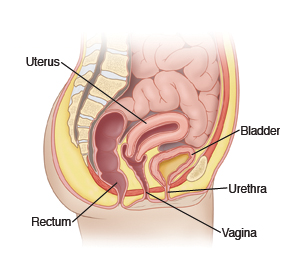Urine normally doesn't have any germs (bacteria) in it. But bacteria can get into the urinary tract from the skin around the rectum. Or they can travel through the blood from other parts of the body. Once they are in your urinary tract, they can cause infection in these areas:
-
The urethra (urethritis)
-
The bladder (cystitis)
-
The kidneys (pyelonephritis)
The most common place for an infection is in the bladder. This is called a bladder infection. This is 1 of the most common infections in women because women have a shorter urethra than men. Bacteria have a shorter distance to travel to reach the bladder.. Women who have gone through menopause also lose the protection from estrogen that lowers the chance of getting a UTI. And some women are at higher risk because of their genes.
Most bladder infections are easily treated. They are not serious unless the infection spreads to the kidney.
The terms bladder infection, UTI, and cystitis are often used to describe the same thing. But they are not always the same. Cystitis is an inflammation of the bladder. The most common cause of cystitis is an infection.
Symptoms
The infection causes inflammation in the urethra and bladder. This causes many of the symptoms. The most common symptoms of a bladder infection are:
-
Pain or burning when urinating
-
Having to urinate more often than normal
-
Urgent need to urinate
-
Only a small amount of urine comes out each time
-
Blood in urine
-
Belly (abdominal) discomfort. This is often in the lower belly above the pubic bone.
-
Lower back pain
-
Cloudy urine
-
Strong- or bad-smelling urine
-
Unable to urinate (urinary retention)
-
Unable to hold urine in (urinary incontinence)
-
Fever
-
Loss of appetite
-
Confusion (in older adults)
Causes
Bladder infections are not contagious. You can't get one from someone else, from a toilet seat, or from sharing a bath.
The most common cause of bladder infections is bacteria from the bowels. The bacteria get onto the skin around the opening of the urethra. From there, they can get into the urine. Then they travel up to the bladder, causing inflammation and infection. This often happens because of:
-
Wiping incorrectly after urinating. Always wipe from front to back.
-
Bowel incontinence
-
Pregnancy. During pregnancy urinary tract changes raise the risk for infection.
-
Procedures, such as having a catheter put in
-
Older age
-
Not emptying your bladder. This can give bacteria a chance to grow in your urine.
-
Fluid loss (dehydration)
-
Constipation
-
Having sex
-
Using a diaphragm and spermicide for birth control
Treatment
Bladder infections are diagnosed by lab exam of a urine sample and urine culture. They are treated with antibiotics. They often clear up quickly without problems. Treatment helps prevent a more serious kidney infection.
Medicines
Medicines can help in the treatment of a bladder infection:
-
Take antibiotics as prescribed, even if you feel better. It's important to finish them to make sure the infection has cleared.
-
You can use acetaminophen or ibuprofen for pain, fever, or discomfort, unless another medicine was prescribed. If you have long-term (chronic) liver or kidney disease, talk with your healthcare provider before using these medicines. Also talk with your provider if you've ever had a stomach ulcer or GI (gastrointestinal) bleeding, or are taking blood-thinner medicines.
-
If you are given phenazopyridine to reduce burning with urination, it will make your urine a bright orange color. This can stain clothing.
Care and prevention
These self-care steps can help prevent future infections:
-
Drink plenty of fluids. This helps to prevent dehydration and flush out your bladder. Do this unless you must restrict fluids for other health reasons, or your healthcare provider told you not to.
-
Clean yourself correctly after going to the bathroom. Wipe from front to back after using the toilet. This helps prevent the spread of bacteria.
-
Urinate more often. Don't try to hold urine in for a long time.
-
Wear loose-fitting clothes and cotton underwear. Don't wear tight-fitting pants.
-
Improve your diet and prevent constipation. Eat more fresh fruits and vegetables, and fiber. Eat less junk foods and fatty foods.
-
Don't have sex until your symptoms are gone.
-
Don't have caffeine, alcohol, and spicy foods. These can irritate your bladder.
-
Urinate right after you have sex to flush out your bladder.
-
If you use birth control pills and have frequent bladder infections, discuss it with your healthcare provider.
Follow-up care
Call your healthcare provider if all symptoms are not gone after 3 days of treatment. This is especially important if you have repeat infections.
If a culture was done, you will be told if your treatment needs to be changed. If directed, you can call to find out the results.
If X-rays were done, you will be told if the results will affect your treatment.
Call 911
Call
-
Trouble breathing
-
Hard to wake up or confusion
-
Fainting (loss of consciousness)
-
Fast heart rate
When to get medical advice
Call your healthcare provider or get medical care right away if any of these occur:
-
Fever of 100.4ºF (38ºC) or higher, or as directed by your healthcare provider
-
Symptoms are not better after 3 days of treatment
-
Symptoms get worse or you have new symptoms
-
Back or belly pain that gets worse
-
Repeated vomiting, or unable to keep medicine down
-
Weakness or dizziness
-
Vaginal discharge
-
Pain, redness, or swelling in the outer vaginal area (labia)


